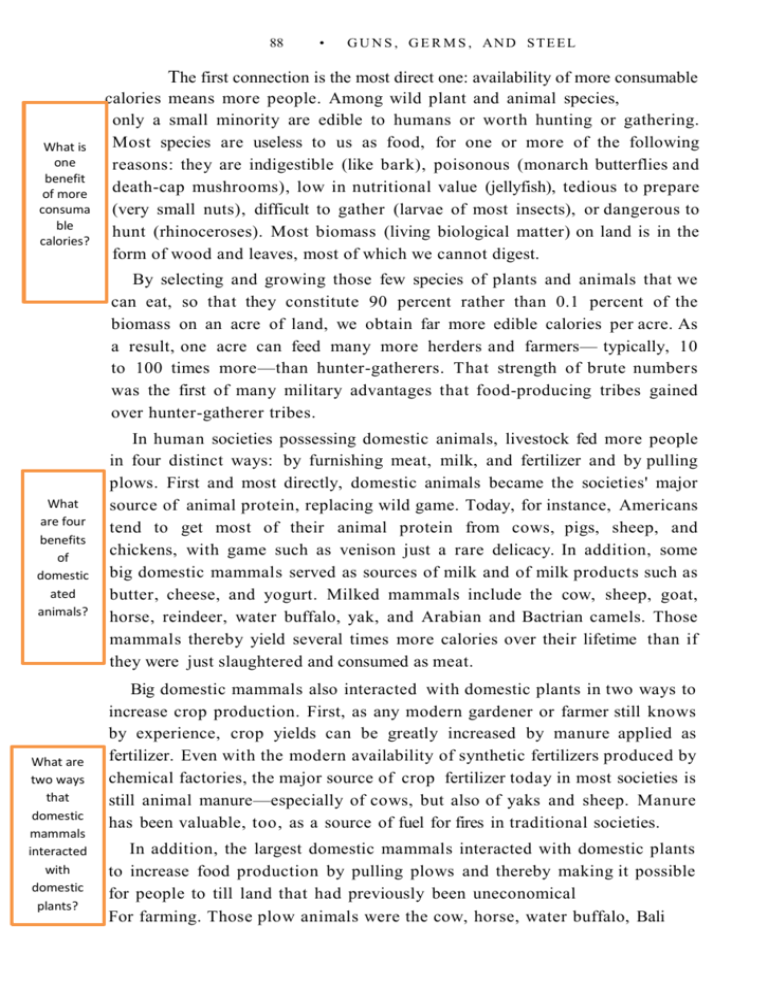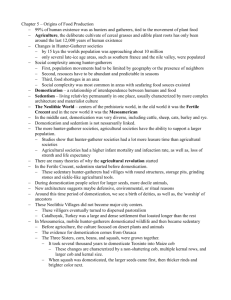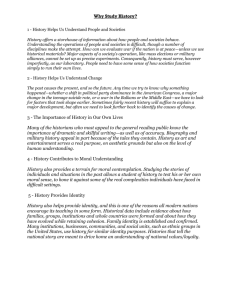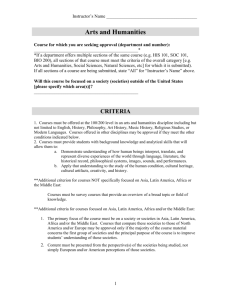88 • GUNS , GERMS , AN D STEE L The first connection is the most
advertisement

88 • G U N S , G E R M S , AN D S T E E L The first connection is the most direct one: availability of more consumable calories means more people. Among wild plant and animal species, only a small minority are edible to humans or worth hunting or gathering. Most species are useless to us as food, for one or more of the following What is one reasons: they are indigestible (like bark), poisonous (monarch butterflies and benefit death-cap mushrooms), low in nutritional value (jellyfish), tedious to prepare of more consuma (very small nuts), difficult to gather (larvae of most insects), or dangerous to ble hunt (rhinoceroses). Most biomass (living biological matter) on land is in the calories? form of wood and leaves, most of which we cannot digest. By selecting and growing those few species of plants and animals that we can eat, so that they constitute 90 percent rather than 0.1 percent of the biomass on an acre of land, we obtain far more edible calories per acre. As a result, one acre can feed many more herders and farmers— typically, 10 to 100 times more—than hunter-gatherers. That strength of brute numbers was the first of many military advantages that food-producing tribes gained over hunter-gatherer tribes. What are four benefits of domestic ated animals? What are two ways that domestic mammals interacted with domestic plants? In human societies possessing domestic animals, livestock fed more people in four distinct ways: by furnishing meat, milk, and fertilizer and by pulling plows. First and most directly, domestic animals became the societies' major source of animal protein, replacing wild game. Today, for instance, Americans tend to get most of their animal protein from cows, pigs, sheep, and chickens, with game such as venison just a rare delicacy. In addition, some big domestic mammals served as sources of milk and of milk products such as butter, cheese, and yogurt. Milked mammals include the cow, sheep, goat, horse, reindeer, water buffalo, yak, and Arabian and Bactrian camels. Those mammals thereby yield several times more calories over their lifetime than if they were just slaughtered and consumed as meat. Big domestic mammals also interacted with domestic plants in two ways to increase crop production. First, as any modern gardener or farmer still knows by experience, crop yields can be greatly increased by manure applied as fertilizer. Even with the modern availability of synthetic fertilizers produced by chemical factories, the major source of crop fertilizer today in most societies is still animal manure—especially of cows, but also of yaks and sheep. Manure has been valuable, too, as a source of fuel for fires in traditional societies. In addition, the largest domestic mammals interacted with domestic plants to increase food production by pulling plows and thereby making it possible for people to till land that had previously been uneconomical For farming. Those plow animals were the cow, horse, water buffalo, Bali FARMER POWER • 89 cattle, and yak / cow hybrids. Here is one example of their value: the first prehistoric farmers of central Europe, the so-called Linearbandkeramik culture that arose slightly before 5000 B.C., were initially confined to soils light enough to be tilled by means of hand-held digging sticks. Only over a thousand years later, with the introduction of the ox-drawn plow, were those farmers able to extend cultivation to a much wider range of heavy soils and tough sods. Similarly, Native American farmers of the North American Great Plains grew crops in the river valleys, but farming of the tough sods on the extensive uplands had to await 19th-century Europeans and their animal-drawn plows. All those are direct ways in which plant and animal domestication led to denser human populations by yielding more food than did the huntergatherer lifestyle. A more indirect way involved the consequences of the sedentary lifestyle enforced by food production. People of many huntergatherer societies move frequently in search of wild foods, but farmers must remain near their fields and orchards. The resulting fixed abode con• tributes to denser human populations by permitting a shortened birth interval. A hunter-gatherer mother who is shifting camp can carry only one child, along with her few possessions. She cannot afford to bear her next child until the previous toddler can walk fast enough to keep up with the tribe and not hold it back. In practice, nomadic hunter-gatherers space their children about four years apart by means of lactational amenorrhea, sexual abstinence, infanticide, and abortion. By contrast, sedentary people, unconstrained by problems of carrying young children on treks, can bear and raise as many children as they can feed. The birth interval for many farm peoples is around two years, half that of hunter-gatherers. That higher birthrate of food producers, together with their ability to feed more people per acre, lets them achieve much higher population densities than hunter-gatherers. A separate consequence of a settled existence is that it permits one to store food surpluses, since storage would be pointless if one didn't remain nearby to guard the stored food. While some nomadic hunter-gatherers may occasionally bag more food than they can consume in a few days, such a bonanza is of little use to them because they cannot protect it. But stored food is essential for feeding non-food-producing specialists, and certainly for supporting whole towns of them. Hence nomadic huntergatherer societies have few or no such full-time specialists, who instead first appear in sedentary societies. Two types of such specialists are kings and bureaucrats. Hunter-gath- What are two other consequen ces of sedentary lifestyles? 90 What are two benefits of a food surplus? • G U N S , G E R M S , AN D S T E E L erer societies tend to be relatively egalitarian, to lack full-time bureaucrats and hereditary chiefs, and to have small-scale political organization at the level of the band or tribe. That's because all able-bodied hunter-gatherers are obliged to devote much of their time to acquiring food. In contrast, once food can be stockpiled, a political elite can gain control of food produced by others, assert the right of taxation, escape the need to feed itself, and engage full-time in political activities. Hence moderate-sized agricultural societies are often organized in chiefdoms, and kingdoms are confined to large agricultural societies. Those complex political units are much better able to mount a sustained war of conquest than is an egalitarian band of hunters. Some hunter-gatherers in especially rich environments, such as the Pacific Northwest coast of North America and the coast of Ecuador, also developed sedentary societies, food storage, and nascent chiefdoms, but they did not go farther on the road to kingdoms. A stored food surplus built up by taxation can support other full-time specialists besides kings and bureaucrats. Of most direct relevance to wars of conquest, it can be used to feed professional soldiers. That was the decisive factor in the British Empire's eventual defeat of New Zealand's well-armed indigenous Maori population. While the Maori achieved some stunning temporary victories, they could not maintain an army constantly in the field and were in the end worn down by 18,000 full-time British troops. Stored food can also feed priests, who provide religious justification for wars of conquest; artisans such as metalworkers, who develop swords, guns, and other technologies; and scribes, who preserve far more information than can be remembered accurately. So far, I've emphasized direct and indirect values of crops and livestock as food. However, they have other uses, such as keeping us warm and providing us with valuable materials. Crops and livestock yield natural fibers for making clothing, blankets, nets, and rope. Most of the major centers of plant domestication evolved not only food crops but also fiber crops—notably cotton, flax (the source of linen), and hemp. Several domestic animals yielded animal fibers—especially wool from sheep, goats, llamas, and alpacas, and silk from silkworms. Bones of domestic animals were important raw materials for artifacts of Neolithic peoples before the development of metallurgy. Cow hides were used to make leather. One of the earliest cultivated plants in many parts of the Americas was grown for nonfood purposes: the bottle gourd, used as a container. Big domestic mammals further revolutionized human society by becom- FARMER POWER • 91 ing our main means of land transport until the development of railroads in the 19th century. Before animal domestication, the sole means of transporting goods and people by land was on the backs of humans. Large mammals changed that: for the first time in human history, it became possible to move heavy goods in large quantities, as well as people, rapidly overland for long distances. The domestic animals that were ridden were the horse, donkey, yak, reindeer, and Arabian and Bactrian camels. Animals of those same five species, as well as the llama, were used to bear packs. Cows and horses were hitched to wagons, while reindeer and dogs pulled sleds in the Arctic. The horse became the chief means of longdistance transport over most of Eurasia. The three domestic camel species (Arabian camel, Bactrian camel, and llama) played a similar role in areas of North Africa and Arabia, Central Asia, and the Andes, respectively. The most direct contribution of plant and animal domestication to wars of conquest was from Eurasia's horses, whose military role made them the jeeps and Sherman tanks of ancient warfare on that continent. As I mentioned in Chapter 3, they enabled Cortes and Pizarro, leading only small bands of adventurers, to overthrow the Aztec and Inca Empires. Even much earlier (around 4000 B.C.), at a time when horses were still ridden bareback, they may have been the essential military ingredient behind the westward expansion of speakers of Indo-European languages from the Ukraine. Those languages eventually replaced all earlier western European languages except Basque. When horses later were yoked to wagons and other vehicles, horse-drawn battle chariots (invented around 1800 B.C.) proceeded to revolutionize warfare in the Near East, the Mediterranean region, and China. For example, in 1674 B.C., horses even enabled a foreign people, the Hyksos, to conquer then horseless Egypt and to establish themselves temporarily as pharaohs. Still later, after the invention of saddles and stirrups, horses allowed the Huns and successive waves of other peoples from the Asian steppes to terrorize the Roman Empire and its successor states, culminating in the Mongol conquests of much of Asia and Russia in the 13th and 14th centuries A.D. Only with the introduction of trucks and tanks in World War I did horses finally become supplanted as the main assault vehicle and means of fast transport in war. Arabian and Bactrian camels played a similar military role within their geographic range. In all these examples, peoples with domestic horses (or camels), or with improved means of using them, enjoyed an enormous military advantage over those without them. What are two military inventions which enhanced the use of domestica ted animals in warfare? 92 What are two other ways that domesticated animals benefitted farming societies • GUNS, GERMS, AND STEEL Of equal importance in wars of conquest were the germs that evolved in human societies with domestic animals. Infectious diseases like smallpox, measles, and flu arose as specialized germs of humans, derived by mutations of very similar ancestral germs that had infected animals (Chapter 11). The humans who domesticated animals were the first to fall victim to the newly evolved germs, but those humans then evolved substantial resistance to the new diseases. When such partly immune people came into contact with others who had had no previous exposure to the germs, epidemics resulted in which up to 99 percent of the previously unexposed population was killed. Germs thus acquired ultimately from domestic animals played decisive roles in the European conquests of Native Americans, Australians, South Africans, and Pacific islanders. In short, plant and animal domestication meant much more food and hence much denser human populations. The resulting food surpluses, and (in some areas) the animal-based means of transporting those surpluses, were a prerequisite for the development of settled, politically centralized, socially stratified, economically complex, technologically innovative societies. Hence the availability of domestic plants and animals ultimately explains why empires, literacy, and steel weapons developed earliest in Eurasia and later, or not at all, on other continents. The military uses of horses and camels, and the killing power of animal-derived germs, complete the list of major links between food production and conquest that we shall be exploring. Name __________________________ Period __________ Questions: 1. What is one benefit of more consumable calories? _____________________________________________________________________________ _____________________________________________________________________________ _____________________________________________________________________________ _____________________________________________________________________________ 2. What are four benefits of domesticated animals? _____________________________________________________________________________ _____________________________________________________________________________ _____________________________________________________________________________ _____________________________________________________________________________ 3. What are two ways that domestic mammals interacted with domestic plants? _____________________________________________________________________________ _____________________________________________________________________________ _____________________________________________________________________________ _____________________________________________________________________________ 4. What are two other consequences of sedentary lifestyles? _____________________________________________________________________________ _____________________________________________________________________________ _____________________________________________________________________________ _____________________________________________________________________________ 5. What are two benefits of a food surplus? _____________________________________________________________________________ _____________________________________________________________________________ _____________________________________________________________________________ _____________________________________________________________________________ 6. What are two other ways that domesticated animals benefitted farming societies _____________________________________________________________________________ _____________________________________________________________________________ _____________________________________________________________________________ _____________________________________________________________________________ 7. What are two military inventions which enhanced the use of domesticated animals in warfare? _____________________________________________________________________________ _____________________________________________________________________________ _____________________________________________________________________________ _____________________________________________________________________________ Useful vocabulary words with definitions. consumable capable of being consumed mi•nor•i•ty 1. the smaller part or number; a number, part, or amount forming less than half of the whole. 2. a smaller group opposed to a majority. ed·i·ble Fit to be eaten, especially by humans indigestible (Physiology) incapable of being digested te·di·ous 1. Tiresome by reason of length, slowness, or dullness; boring Constitute to make up; form; compose distinct 1. easily sensed or understood; clear; precise 2. (when postpositive, foll by from) not the same (as); separate (from); distinguished (from) 3. not alike; different 4. sharp; clear uneconomical - inefficient in use of time and effort and materials; do·mes·ti·cate To train or adapt (an animal or plant) to live in a human environment and be of use to humans. sed·en·tar·y Remaining or living in one area, a·bode A dwelling place; a home unconstrained not having any constraints den·si·ty The number of individuals, such as inhabitants or housing units, per unit of area e·gal·i·tar·i·an Affirming, promoting, or characterized by belief in equal political, economic, social, and civil rights for all people. bureaucracy a system of administration based upon organization into bureaus, division of labour, a hierarchy of authority, etc: designed to dispose of a large body of work in a routine manner he·red·i·tar·y Descending from an ancestor to a legal heir; passing down by inheritance obliged - under a moral and social obligation to do something nas·cent Coming into existence; emerging jus·ti·fi·ca·tion a. The act of justifying. b. The condition or fact of being justified. sup•plant 1. to take the place of (another), as through force, scheming, or strategy. 2. to replace (one thing) by something else. sub·stan·tial Ample; sustaining: ep·i·dem·ic Spreading rapidly and extensively by infection and affecting many individuals in an area or a population at the same time: an epidemic outbreak of influenza. An outbreak of a contagious disease that spreads rapidly and widely.










